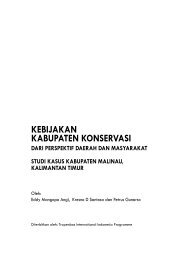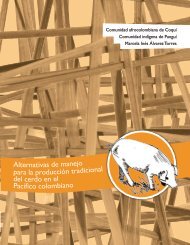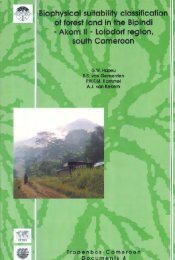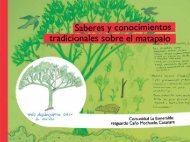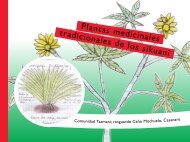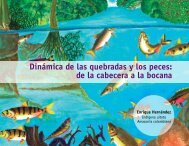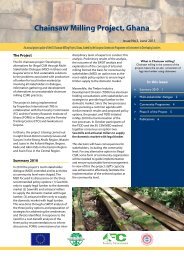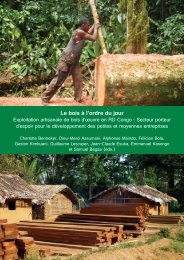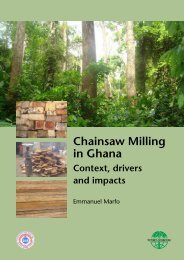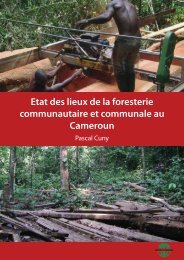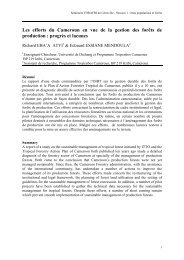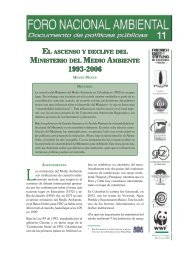Download the publication - Tropenbos International
Download the publication - Tropenbos International
Download the publication - Tropenbos International
You also want an ePaper? Increase the reach of your titles
YUMPU automatically turns print PDFs into web optimized ePapers that Google loves.
Diversity patterns in <strong>the</strong> flora of <strong>the</strong> Campo-Ma’an rain forest, Cameroon: do tree species tell it all?<br />
3.1. INTRODUCTION<br />
In a large, heterogeneous and structurally complex forest ecosystem such as <strong>the</strong><br />
Campo-Ma’an tropical rain forest, selection of <strong>the</strong> most appropriate methods for <strong>the</strong><br />
assessment of plant biodiversity is a difficult matter. So far, many botanical<br />
biodiversity studies in tropical rain forest are often limited to tree species (mainly<br />
medium and large trees, or for some cases trees with DBH ≥ 10 cm) which are<br />
assumed to reflect <strong>the</strong> forest floristic composition and physical structure (Letouzey,<br />
1968; Reitsma, 1988; Hart et al., 1989; Mosango, 1990; Koubouana, 1993; Wolter,<br />
1993; Lejoly, 1995a & 1995b; Newbery & Gartlan 1996; White, 1996; Sonké, 1998,<br />
Sonké & Lejoly 1998; van Valkenburg 1998). Moreover, for most of <strong>the</strong>se studies<br />
tree species accounted for more than 50% of <strong>the</strong> overall species composition. This<br />
traditional approach of forest inventory might not be sufficient for biodiversity<br />
assessment because o<strong>the</strong>r taxa such as shrubs, small trees, woody lianas, herbaceous<br />
climbers, herbs and epiphytic flora are not or under-represented. Fur<strong>the</strong>rmore, it has<br />
been shown in Central and West Africa that many plant species of high conservation<br />
value such as endemic and rare species are shrub and herbaceous species (Letouzey,<br />
1968 & 1985; Robbrecht, 1996; Sosef, 1996; Achoundong, 2000; Cable & Cheek,<br />
1998). Therefore, assessments based solely on trees might be inadequate for<br />
conservation purposes.<br />
In Chapter 2, we classified, described and mapped <strong>the</strong> various vegetation types<br />
recorded in <strong>the</strong> Campo-Ma’an area and analysed <strong>the</strong> forest structure and<br />
composition. In this Chapter we will study <strong>the</strong> diversity and distribution of <strong>the</strong> flora<br />
in <strong>the</strong> Campo-Ma’an rain forest, and find out whe<strong>the</strong>r <strong>the</strong>re is a correlation between<br />
tree species diversity and diversity of o<strong>the</strong>r growth forms such as shrubs, herbs and<br />
lianas. This will help us to understand if, in <strong>the</strong> contest of African tropical rain<br />
forest, tree species diversity tells it all. Are forests that are rich in tree species also<br />
rich in o<strong>the</strong>r life forms?<br />
3.2. METHODS<br />
Field sampling<br />
Representative and homogeneous vegetation types were selected on <strong>the</strong> basis of<br />
physical and human factors such as altitude, slopes, rainfall, soils and land use<br />
(Chapter 2). Sampling was carried out in small plots of 0.1 ha at irregular intervals<br />
along a line transect from a random starting point. In mountainous areas, plots were<br />
located at an altitudinal interval of 200 m along <strong>the</strong> slope and on both sides of <strong>the</strong><br />
ridge. In total 147 plots covering 14.7 ha were established and in each 0.1 ha plot,<br />
all trees, shrubs, herbs and lianas with DBH ≥ 1 cm were measured, recorded and<br />
identified as far as possible. For unknown species, a voucher specimen was<br />
collected. Herbaceous species and seedlings of trees, shrubs and climbers were<br />
sampled in subplots of 5 m x 5 m each that were established in <strong>the</strong> 0.1 ha plots.<br />
These subplots were not used for <strong>the</strong> analyses, <strong>the</strong> output was only used to illustrate<br />
<strong>the</strong> contribution of <strong>the</strong> ground layer and herbaceous species when all vascular plant<br />
species are included in <strong>the</strong> floristic assessment of <strong>the</strong> forest.<br />
43



